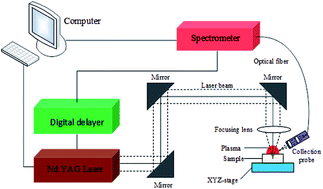当前位置:
X-MOL 学术
›
Anal. Methods
›
论文详情
Our official English website, www.x-mol.net, welcomes your
feedback! (Note: you will need to create a separate account there.)
The basicity analysis of sintered ore using laser-induced breakdown spectroscopy (LIBS) combined with random forest regression (RFR)
Analytical Methods ( IF 2.7 ) Pub Date : 2017-08-02 00:00:00 , DOI: 10.1039/c7ay01389b Guang Yang 1, 2, 3, 4 , Xu Han 1, 2, 3, 4 , Chenghao Wang 1, 2, 3, 4 , Yu Ding 5, 6, 7, 8 , Ke Liu 1, 2, 3, 4 , Di Tian 1, 2, 3, 4 , Li Yao 2, 8, 9, 10
Analytical Methods ( IF 2.7 ) Pub Date : 2017-08-02 00:00:00 , DOI: 10.1039/c7ay01389b Guang Yang 1, 2, 3, 4 , Xu Han 1, 2, 3, 4 , Chenghao Wang 1, 2, 3, 4 , Yu Ding 5, 6, 7, 8 , Ke Liu 1, 2, 3, 4 , Di Tian 1, 2, 3, 4 , Li Yao 2, 8, 9, 10
Affiliation

|
The basicity of sintered ore, which is related to the melting point of the sinter, is vital to ore mining and blast-furnace smelting. Laser-induced breakdown spectroscopy (LIBS) with random forest regression (RFR) has been applied for measuring the basicity of sintered ore, which can be defined by the concentrations of oxides: CaO, SiO2, Al2O3 and MgO. In this work, thirty sintered ore samples are used, of which twenty samples are used for the calibration set to construct the random forest regression (RFR) calibration model for the above-mentioned oxides and ten samples are used for the test set. The characteristic lines of the main components in the sintered ore are identified using the National Institute of Standards and Technology (NIST) database. Two model parameters (the number of decision trees – ntree and the number of random variables – mtry) of the RFR were optimized by out-of-bag (OOB) error estimation for improving the predictive accuracy of the RFR model. The RFR model was applied to sample measurements and the results were compared with partial least squares regression (PLSR) models. The RFR model has shown better predictive capabilities than the PLSR model. In order to verify the stability of the RFR model, fifty measurements were made and the relative standard deviation (RSD) of the data is between 0.27% and 0.59%. Therefore, LIBS combined with RFR could be a promising method for real-time online, rapid analysis in mining and mineral processing industries.
中文翻译:

激光诱导击穿光谱法(LIBS)结合随机森林回归(RFR)对烧结矿进行碱度分析
与烧结矿的熔点有关的烧结矿的碱度对矿石开采和高炉冶炼至关重要。具有随机森林回归(RFR)的激光诱导击穿光谱(LIBS)已用于测量烧结矿的碱度,该碱度可由氧化物的浓度来定义:CaO,SiO 2,Al 2 O 3和氧化镁。在这项工作中,使用了三十个烧结矿样品,其中二十个样品用于校准集,以构建上述氧化物的随机森林回归(RFR)校准模型,十个样品用于测试集。烧结矿中主要成分的特征线可使用美国国家标准技术研究院(NIST)数据库进行识别。两个模型参数(决策树的数量– ntree和随机变量的数量– m tryRFR)通过袋外(OOB)误差估计进行了优化,以提高RFR模型的预测准确性。将RFR模型应用于样本测量,并将结果与偏最小二乘回归(PLSR)模型进行比较。与PLSR模型相比,RFR模型显示出更好的预测能力。为了验证RFR模型的稳定性,进行了50次测量,数据的相对标准偏差(RSD)在0.27%至0.59%之间。因此,LIBS与RFR结合可以成为采矿和选矿行业中实时在线,快速分析的有前途的方法。
更新日期:2017-09-21
中文翻译:

激光诱导击穿光谱法(LIBS)结合随机森林回归(RFR)对烧结矿进行碱度分析
与烧结矿的熔点有关的烧结矿的碱度对矿石开采和高炉冶炼至关重要。具有随机森林回归(RFR)的激光诱导击穿光谱(LIBS)已用于测量烧结矿的碱度,该碱度可由氧化物的浓度来定义:CaO,SiO 2,Al 2 O 3和氧化镁。在这项工作中,使用了三十个烧结矿样品,其中二十个样品用于校准集,以构建上述氧化物的随机森林回归(RFR)校准模型,十个样品用于测试集。烧结矿中主要成分的特征线可使用美国国家标准技术研究院(NIST)数据库进行识别。两个模型参数(决策树的数量– ntree和随机变量的数量– m tryRFR)通过袋外(OOB)误差估计进行了优化,以提高RFR模型的预测准确性。将RFR模型应用于样本测量,并将结果与偏最小二乘回归(PLSR)模型进行比较。与PLSR模型相比,RFR模型显示出更好的预测能力。为了验证RFR模型的稳定性,进行了50次测量,数据的相对标准偏差(RSD)在0.27%至0.59%之间。因此,LIBS与RFR结合可以成为采矿和选矿行业中实时在线,快速分析的有前途的方法。











































 京公网安备 11010802027423号
京公网安备 11010802027423号